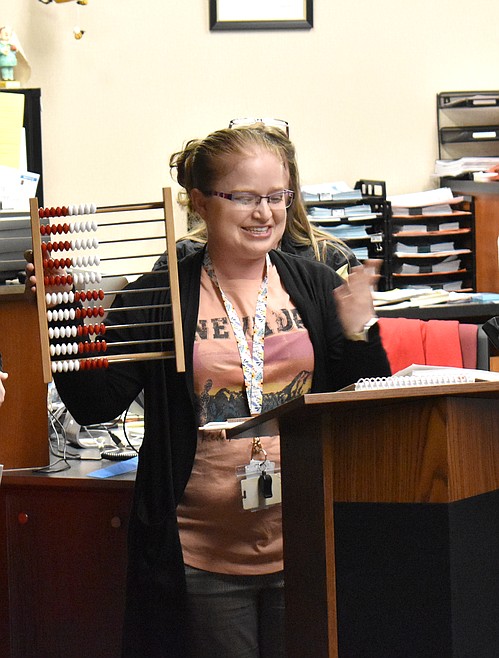Royal schools adopt new math curriculum
JOEL MARTIN | Hagadone News Network | UPDATED 2 years, 8 months AGO
Joel Martin has been with the Columbia Basin Herald for more than 25 years in a variety of roles and is the most-tenured employee in the building. Martin is a married father of eight and enjoys spending time with his children and his wife, Christina. He is passionate about the paper’s mission of informing the people of the Columbia Basin because he knows it is important to record the history of the communities the publication serves. | March 31, 2023 1:30 AM
ROYAL CITY — Royal schools will be seeing some changes in math after the Royal School Board voted unanimously at its meeting Monday to adopt new K-3 and 4-6 math curricula.
The curriculum for elementary students is called Eureka Math2 and makes extensive use of hands-on and digital aids. Second-grade teacher Rachel Dubes showed the board one such aid, an abacus-like device called a Rekenrek, and described how it had spurred her students into multiplication.
“We're counting by twos and I'm counting along, and one of the kids raises their hand, and says ‘I just noticed something. I noticed that when you count by twos, you're also counting by fours, and by eights. And I think there's more!’ And then they start having a discussion (about it). That’s stuff I was trying to get fifth-graders to learn, back when I taught fifth grade,” Dube said of her experiences using the new curriculum.
Eureka Math2 puts more emphasis on graphic visual aids rather than on written words, Dubes said, which makes learning math easier for children who are still building their literacy.
Board President Craig Janett was a little skeptical at first.
“As long as I've been around, they keep coming up with new math, and new math never works,” Janett said. “So I'm interested, is this the standard, regular old math?”
“I think you're referring to the standard algorithm, right?” Dubes answered. “Like, carry the one and borrow and that kind of thing. That's the goal, is to get them to where they are fluent in that. But we also want to build that conceptual understanding prior to that … so that they can be successful later on with some of the old math, I guess you could probably call it. We feel like it has a good balance of that.”
The curriculum the board chose for the intermediate school is called Illustrative Mathematics, and was introduced by sixth-grade teacher Aislinn Bufi. Illustrative Mathematics also focuses more on visual representations than on numbers, Bufi said, enabling students to find a process that works for them.
“Now that I started teaching Illustrative, I stand in the back of the classroom a lot, and let them do it,” Bufi said. “And they're discovering their own strategies ... which helps address all levels of math, especially because most of the time our brains tend to think about math pictorially, before numerically, because it's a little bit easier for us to just comprehend.”
The board also saw a presentation by the early learning team, who discussed the successes their program is having moving students from preschool into kindergarten.
“I started teaching in 1993,” special education preschool teacher Becky Noftle said. “And this (transitional kindergarten) program is the thing I've been most excited about in all my years of education, because I can actually see the needle move. You want them, when they leave their grade, to be on grade level in reading and math. And it's so hard when the first year of school is spent trying to cognitively work out two different languages and translate everything in their head. They spend so much energy doing that ... If they haven't been read to very much, they literally start the year not able to listen to a small picture book, and then when it gets to Dr. Seuss week in March … they've really increased their skills and their cognition. So it's exciting.”
Joel Martin can be reached via email at [email protected].
ARTICLES BY JOEL MARTIN

Wahluke Jr. High earns Culture Kick-Off Award again
MATTAWA — Wahluke Junior High School has been honored with the 2025 Culture Kickoff Award for the second year in a row, according to an announcement from the Association of Washington School Leaders and the Association of Washington School Principals.

Cops for Tots
Moses Lake Police collect toys for local children
MOSES LAKE — The Moses Lake Police Department is focused on supporting local children this year with their revamped annual toy drive. “We had been doing this for a while, through Toys for Tots,” said MLPD Public Records Technician Cristina Valdez. “But last year we decided to change it to Cops for Tots so that we could make sure the toys stayed within our own community.” Officers and support staff stationed themselves outside both entrances of the Moses Lake Walmart Saturday evening.

Local bean bag champ eyes pro game
MOSES LAKE — We’ve seen the game at almost every outdoor community gathering: two or more players tossing bean bags at a board tilted up at an angle, aiming for a hole in the board. But that bean bag toss game, also called cornhole, is more than just a casual pastime; it’s a serious sport with dedicated players. “I’m trying to go pro right now,” said Camryn Barrientoz of Moses Lake. “I was No. 2 in Washington, and since I did really well in this regional (tournament), it got me enough points where it bumped me up to No. 1 in Washington.” That regional tournament was held in Wenatchee Dec. 12-13, and Camryn, along with his doubles partner Jay Robins, took back-to-back titles, according to an email Camryn sent the Columbia Basin Herald.

